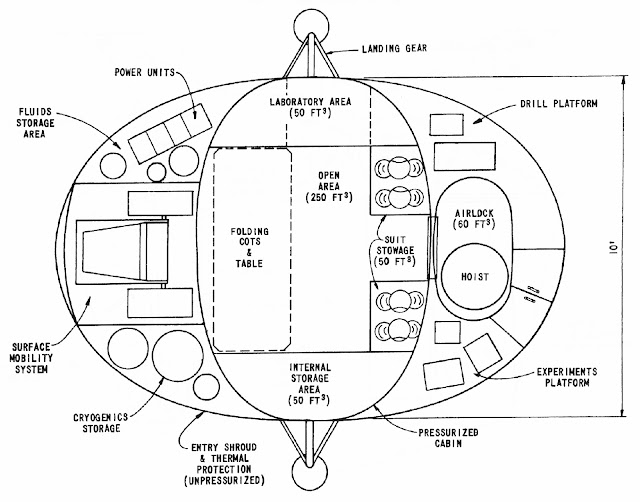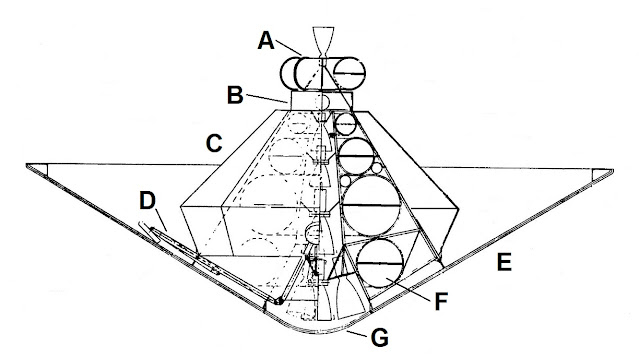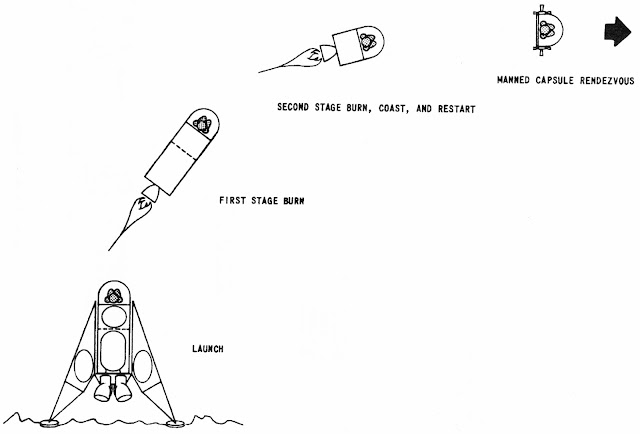The piloted flyby spacecraft would have released the MSSR perhaps 10 days before Mars close encounter. A rocket motor on the MSSR would have boosted it toward Mars, enabling it to reach the planet and land at a preselected site several hours before the piloted flyby spacecraft arrived.
The crew on board the piloted flyby spacecraft would have used a variety of sample collectors on board the MSSR to gather about two pounds of Mars surface material and air by remote control as the planet grew ever larger in their viewports. These would have been packed into a three-stage ascent vehicle and launched to the piloted flyby spacecraft.
Phase 1 of the Planetary JAG piloted flyby study ended with distribution of an NASA report on 3 October 1966. The group then began work on Phase 2 of its piloted flyby study. Some members of the Planetary JAG foresaw a rosy future for the concept — they anticipated that MSSR study contracts might be awarded in Fiscal Year 1968 and the piloted flyby mission might become a NASA new start project in Fiscal Year 1969.
Even before the AS-204/Apollo 1 fire (27 January 1967), however, NASA planning for missions beyond Apollo was on shaky ground. Neither the Administration of President Lyndon Baines Johnson nor the Congress supported ambitious plans for post-Apollo spaceflight — for example, a long-term lunar base or humans on Mars. By the summer months of 1967, the fire, racial and anti-war tensions across the country, concerns about the Federal budget deficit, and military setbacks in Indochina had provided opponents of an expansive U.S. future off the Earth with ample justification for curtailing NASA efforts to define its future.
Not all advance planning halted, however. Bellcomm, NASA's Washington, DC-based planning contractor, continued its work as a matter of course. Most Bellcomm studies in the 1967-1969 period aimed to define the shape of the Apollo Program after the first successful piloted lunar landing, as well as that of Apollo's planned successor, the Earth-orbital and lunar Apollo Applications Program (AAP). A modicum of work toward more ambitious goals beyond Earth orbit and the Moon also continued.
In July 1967, for example, Bellcomm planners D. Cassidy and H. London completed a short technical memorandum in which they explored how the MSSR probe might form the basis for a piloted Mars Excursion Module (MEM) lander. Their study kicked off a series of related studies at Bellcomm in the year that followed.
Cassidy and London assumed a 15,000-pound MSSR with a two-stage ascent vehicle capable of launching 80 pounds to a passing piloted flyby spacecraft launched in 1975, 1977, or 1979 on a Mars Twilight flyby path. The "Twilight" mission owed its name to the geometry of its Mars flyby — closest approach to Mars took place over the planet's night hemisphere near the dawn terminator, the line dividing pre-dawn darkness from daylight.
The Bellcomm engineers calculated that MSSR Mars atmosphere entry velocity would reach 32,500 feet per second (fps) in 1975, 34,500 fps in 1977, and 39,000 fps in 1979. As it passed at a shallow angle through the thin martian atmosphere, the automated MSSR would undergo deceleration equal to up to 40 times the pull of gravity on Earth's surface (that is, 40 Gs). To accomplish rendezvous with the passing piloted Mars flyby spacecraft, the MSSR ascent vehicle would have to boost an 80-pound third stage and sample container to 36,000 fps in 1975, 38,000 fps in 1977, and 42,500 fps in 1979.
An MSSR-derived MEM released during piloted Mars orbiter approach to Mars — that is, before the orbiter fired its rocket motors to slow down so that Mars's gravity could capture it into an elliptical orbit with a one-day period — would, on the other hand, in 1978, 1982, 1984, 1985, and 1986 enter the martian atmosphere moving at between 20,000 fps and 25,000 fps. It would decelerate at about 10 Gs, which Cassidy and London judged to be acceptable for an astronaut.
 |
| MSSR-derived minimum MEM. Image credit: Bellcomm/NASA. |
Cassidy and London explained that a separate Bellcomm study, not yet completed when they finished their July 1967 memorandum, had determined that a minimum one-person MEM with a crew capsule weighing as little as 600 pounds without an astronaut on board might be possible. Such a MEM would carry only enough life support consumables to remain on Mars for a short time and no scientific exploration equipment.
Anticipating that a mission so limited might not enjoy much support, they briefly examined one that employed three MSSR-derived landers: a pair of minimum MEMs carrying one astronaut each and an automated one-way cargo lander for delivering 5,500 pounds of life support supplies and science gear. The three landers would touch down near each other so that the two astronauts could meet up and make use of the cargo.
Skeer eliminated 47% of Mercury's weight immediately by deleting the 1119-pound launch escape tower, 315-pound heat shield, 317-pound retrograde propulsion system (used to deorbit the Mercury capsule), landing systems and recovery gear together weighing 343 pounds, and 51 pounds of experiments. He then treated remaining Mercury systems in detail. He wrote, for example, that McDonnell engineers had told him that the 75-pound Mercury couch could be trimmed to 15 pounds. Skeer arrived at a total MEM ascent stage weight of 738 pounds including a 170-pound astronaut.
 |
| Minimum MEM entry and landing. Image credit: Bellcomm/NASA. |
 |
| Useful payload: two-stage minimum MEM ascent vehicle. Image credit: Bellcomm/NASA. |
The astronaut packed into the coffin-like MEM cabin would rely for life support on a 40-pound space suit with a 100-pound life support backpack containing sufficient life support consumables for 12 hours of operations. This combination would replace a Mercury cabin life support system weighing 248 pounds.
Skeer briefly examined a two-person minimum MEM with a descent stage not based directly on the piloted flyby MSSR. This would, he wrote, have a total weight of less than 35,000 pounds. Of this, 1360 pounds would comprise the MEM ascent stage and crew. He clearly favored the single-person minimum MEM, however.
Skeer subsequently conducted a pair of follow-on studies of MSSR-derived piloted spacecraft. The first, completed on 8 May 1968, looked at a 4064-pound MSSR-derived two-person surface shelter that would enable a two-week Mars surface stay by astronauts landed separately in a pair of MSSR-derived minimum MEMs. Expendables supporting the two-week stay — mostly for life support and power generation — would account for 1053 pounds of the shelter's weight.
 |
| Cutaway view of MSSR-derived Mars surface shelter. Image credit: Bellcomm/NASA. |
 |
| Plan view of MSSR-derived Mars surface shelter. Image credit: Bellcomm/NASA. |
Scientific exploration equipment accounted for 1460 pounds of the shelter's weight. This included a single 367-pound one-person surface rover or flyer with a total range of 420 kilometers, 77 pounds of multiband photography/radiometry equipment, a 107-pound shelter-mounted drill capable of reaching a depth of 30 meters, 100 pounds of "surveying tools," a 250-pound "Emplaced Science Station" and three "satellite science stations" (total weight 140 pounds) meant to be left behind on the martian surface, and "local sampling and environmental equipment" weighing a total of 395 pounds. The shelter's pressurized cabin would contain 50 pounds of equipment for geologic analysis. (Skeer made no reference to return of samples in the two minimum MEM vehicles; presumably sample analysis on Mars was meant to replace return of samples to Earth.)
Skeer's second follow-on study, a more detailed examination of the minimum MEM ascent stage dated 8 July 1968, sought to identify "fruitful areas of technological research and development needed for evaluation and future program planning options." He argued for development of new propulsion systems capable of burning new high-energy propellants (for example, fluorine-LOX/methane), compact and lightweight refrigeration systems for long-term storage of such propellants, and development of new lightweight materials to permit further minimum MEM weight reduction.
He also noted that flights of MSSR probes during piloted flyby missions could be seen as test flights of minimum MSSR technology. Unfortunately, by the time Skeer completed his second follow-on study, work within the NASA Planetary JAG toward a piloted flyby with MSSR probe had been largely abandoned for nearly a year.
Sources
"MSSR/MEM Commonality - Case 233," D. E. Cassidy and H. S. London, Bellcomm, Inc., 19 July 1967.
"Preliminary Sizing of a Mars Excursion Module Ascent Capsule Based on Mercury Spacecraft Design - Case 233," M. H. Skeer, Bellcomm, Inc., 25 September 1967.
"Preliminary Mars Excursion Module Shelter Design - Case 730," M. H. Skeer, Bellcomm, Inc., 8 May 1968.
"Mars Excursion Module Ascent Propulsion Stage Design," M. H. Skeer, Bellcomm, Inc., 8 July 1968.
More Information
A New Step in Spaceflight Evolution: To Mars by Flyby-Landing Excursion Mode (1966)
NASA's Planetary Joint Action Group Piloted Flyby Study (1966)
Triple-Flyby: Venus-Mars-Venus Piloted Missions in the Late 1970s/Early 1980s (1967)
Flyby's Last Gasp: North American Rockwell's S-IIB Interplanetary Booster (1968)





That's terrifyingly bare-bones, I wonder if they'd have found anyone brave enough to fly in it.
ReplyDeleteThis plan makes me think of some of the other high-risk plans we've seen proposed, such as the one-way lunar mission. It might be do-able, but it would require very special circumstances - the high level of risk would have to be seen as acceptable for some reason.
DeleteAlthough it wasn't a pot of gold, it got us to where we are today! Love the history lesson.
ReplyDeleteIt looks like a spectacularly expensive way to commit suicide!
ReplyDeleteAs I understand it, current technology has still not defined useful (crewed) weight Mars lander methods. I'd love to see a movie based on an updated version of this, perhaps in response to some sort of "got to get boots on Mars NOW!" situation ("I'm not saying its aliens, but..."). As to a one-man lander THEN...he'd be one busy Right Stuff guy, to say the least...
ReplyDeleteThis proposal does have a cinematic quality to it! My understanding is the pilot in this contraption wouldn't have had much piloting to do in this design. He'd have had almost no controls or instruments. Engineers have come up with lots of Mars crew lander designs but it's true that no Mars lander yet flown approaches the scale of a crew lander. The design of the MEM in this post is based on the aeroshell design developed for the Voyager Mars program, the one Viking replaced (and then we recycled the name for Mariner Jupiter-Saturn). We've never flown this conical "coolie hat" aeroshell design. After Mariner IV, we gravitated toward blunt-body designs shaped like Apollo for crew landers, and we still see that proposed. I think the Viking-type "lozenge" aeroshell, which is what we still use today, is nearing its maximum size — I don't think it has ever been proposed for a crew lander.
DeleteThis seems as good a place and time as any to ask a Really Dumb Question. As a thought experiment, if a Mars-orbiting spacecraft's orbital velocity ceased to exist, it would then free-fall from orbit, presumably reaching (but not exceeding) Mars gravity's terminal velocity (right?). This being impossible, what if a large retro-burn (high gee/thrust, short duration) were applied to reduce velocity as quickly and as much as the crew could stand? Could a free-fall state be thereby approached? (I suspect the answer is, "No; the laws of physics would have the spacecraft decelerating/descending from the instant of application of thrust, thereby exceeding terminal velocity") (right?)
DeleteIf through magic orbital velocity simply vanished, then the spacecraft would fall toward the center of the nearest large object (Mars, in this case). The atmosphere would play a role at some point. If by a really powerful rocket retro-burn, there'd be some sort of "slope" to the descent, and again the atmosphere would play a role at some point. I'm not sure about use of the phrase "free-fall state" — my understanding (quite possibly imperfect) is that a spacecraft orbiting another body is in a state of free fall, with some micro-G effects that normally don't count for much on a human scale. Not sure if I'm making sense here. dsfp
Delete